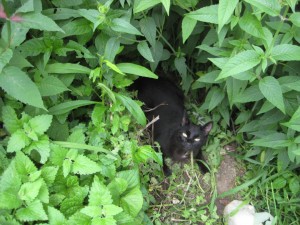Cataria nepeta. That’s some strong stuff, man. You don’t want to let your cat drive or operate power tools for several hours after a hit of this stuff.
Catnip is a member of the mint family, bland and unobtrusive in the garden, with dull gray-purple flowers. Humans rarely notice it. But for some reason, giving a sprig of catnip to a cat is like handing a human an uncorked bottle of Jack Daniels.
It seems to affect individual cats differently. Some cats are rowdy drunks, reeling around the house yowling and swinging from the chandelier. Others quietly collapse in a heap and sleep it off. Approximately a third of cats are completely unimpressed by it.
Nepetalactone is a chemical found in the essential oils present in the leaves and stems of the catnip plant. It triggers a complex process in the brains of cats, which is not completely understood by scientists. (Actually, very little about cats is understood by scientists.) Some researchers say catnip targets the areas of the brain that control sexual behavior. Others say it has some sort of hallucinogenic effect. Only the Pussycat knows for sure, and he’s not talking.
This stuff that affects feline brains so powerfully seems to have minimal effects on humans. There’s some anecdotal evidence that catnip tea is a very mild sedative, and it was traditionally used as a calming nightcap for fractious children. I’m personally fond of catnip tea for an upset stomach. I put a handful of leaves and stems in a glass jar, fill it up with hot water, and let it steep for a few minutes. Bland but very soothing. Perhaps fortunately, it doesn’t affect me the way it does my cat.






Recent Comments